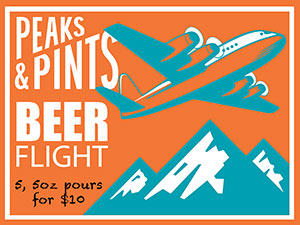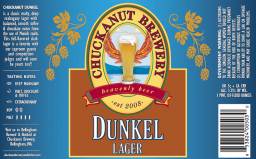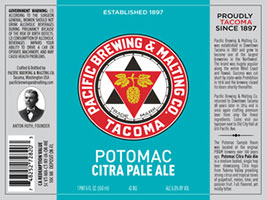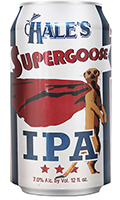 Friday, Sept. 8, 2017, Peaks and Pints presents a craft beer flight of Washington state’s oldest breweries that we call Craft Beer Crosscut 9.8.17: A Flight of Washington State’s Oldest Breweries. Catchy name, huh? The following is how the flight was formed.
Friday, Sept. 8, 2017, Peaks and Pints presents a craft beer flight of Washington state’s oldest breweries that we call Craft Beer Crosscut 9.8.17: A Flight of Washington State’s Oldest Breweries. Catchy name, huh? The following is how the flight was formed.
4,300 BC — Oldest-known written recipe — a formula for beer — inscribed in clay cuneiform tablet. The Babylonians are producing beer in large quantities with around 20 varieties, including Suck It Sumerian Stout.
500-1000 AD — The first half of the Middle Ages, brewing begins in European monasteries and convents; hops added to process. Hello Bring Out Your Dead IPA!
1490 — Columbus finds Native Americans making beer from corn and tree sap in the Bahamas. First Caribbean bar fight breaks out when the natives called Columbus a phony.
1612 — First commercial New World brewery opens in New Amsterdam (now Manhattan, in New York City).
1620 — Mayflower docks at Plymouth Rock; ship’s log notes landing hastened by fears over dwindling supplies, “especially our beere.” The Puritans pointed fingers at the Pilgrims.
1772 — Ralph Harwood, a London brewer, invents Porter (a dark-and-light-malts mixture). Porter made its way to Ireland in 1776 and Guinness was brewing it a few years later.
1810 — An estimated 132 operating breweries exist in the United States.
1820s — English brewers create strong, heavily hopped brews — now known as India Pale Ales — to withstand arduous travels from England to India. Lord Liverpool makes the first bitter-beer face.
1842 — Golden lager launched in Plzen, Bohemia. “Girls Night Out” Pilsner Urquell drunken karaoke is invented.
1844 — The Empire Brewery opens in Milwaukee, Wisconsin, later to become Pabst Brewing Company. Many years in the future, Portland hiccups.
1873 — An estimated 4,131 operating breweries exist in the United States.
1876 — Automatic bottling and pasteurization is developed to stabilize beers, 22 years before the process was applied to milk.
1883 — Andrew Hemrich and partner John Kopp established Bay View Brewery that would eventually become the Rainier Brewery.
1888 — Diedrich Stegmann and Henry Lusthoff formed the United States Brewing & Ice Co. at 23rd and Jefferson in downtown Tacoma.
1891 — May, Samuel S. Loeb and his brother-in-law, Albert Weinberg, purchased controlling interest in the United States brewery.
1891 — July, Andrew Hemrich, proprietor of the Bay View Brewery in Seattle buys Diedrich Stegmann’s shares in the United States brewery of Tacoma, which will be remodeled and renamed the Milwaukee Brewing Company.
1891 — August, The Puget Sound Brewery was incorporated as the Puget Sound Brewing Company in Tacoma, with a capital stock of $600,000. John D. Scholl was the firm’s president, with Anton Huth, treasurer and Peter A. Kalenborn, secretary.
1893 — Bay View Brewery joined with the breweries of Albert Braun and Claussn-Sweeney to form a new association, the Seattle Brewing & Malting Company. The brand name eventually chosen for the company’s flagship beer was “Rainier.” The Bay View plant continued to operate, and in 1906 added a bottling shop and additional refrigeration.
1897 — The Milwaukee Brewing Company in Tacoma gives a warranty deed to the Puget Sound Brewing Company for its brewery and all property connected therewith for a consideration named in the deed of $1, and the Pacific Brewing & Malting Company filed articles of incorporation, with a capital stock of $500,000 to carry on the business of the two breweries. The trustees of the new company are William Virges of the Bonney Drug Company, treasurer; Anton Huth, president of the Puget Sound Brewing Company, president; S.S. Loeb, president of the Milwaukee Brewing Company, secretary. Pacific Brewing & Malting Co. grew to become the second largest brewery in Washington state, until shut down by Prohibition in 1916.
1920-1933 — When the 18th Amendment passed on January 17, 1920, the sale, production, and transportation of liquor became illegal. As we all know, this ushered in an era of underground parties, colorful gangsters and the height of jazz.
1933 —Prohibition ends for beer (April 7).
1935 — Only 160 breweries survived Prohibition. The beer can is introduced. During Babe Ruth’s last career game, playing for the Boston Braves against the Phillies, a Philadelphian frat boy cuts a jagged hole in a beer can, awkwardly cranks his heads sideways and drinks the beer in 4.2 seconds.
1965 — Fritz Maytag uses part of washing-machine fortune to rescue failing Anchor Brewing Company in San Francisco.
1965 — Short-lived New Albion Brewery, recognized as first American “microbrewery,” opens in California with two-barrel brew house.
1973 — Ten-year-old me solves “LIS + sun + two + Y + oar + L + door + S” on a Lucky Lager cap, rewarded with a sip. So it begins.
1981 — Gordon Bowker and Paul Shipman establish Redhook Brewery in an old Ballard transmission shop with the goal of brewing Seattle a better beer.
1982 — The first Redhook Ale ever is poured at the classic Seattle pub in Queen Anne, Jake O’Shaughnessy’s. The initial beer had a fruity taste and quickly gained a cult following as “Banana Beer.”
1983 — Yakima Brewing and Malting Company (the first modern brew pub) opens in Washington state; 51 U.S. breweries (record low), most making similar pilsner-style lager; top six breweries — Anheuser-Busch, Miller, Heileman (later bought by Stroh), Stroh (later bought by Pabst), Coors and Pabst — control 92 percent of U.S. beer production.
1983 — Mike Hale starts Hale’s Ales Ltd. In the small town of Colville about 70 miles north of Spokane. He gathered investors and equipment—mostly of the used-dairy variety — and built a 10-barrel system that included open fermenters similar to the way things were done in England.
1984 — Will and Mari Kemper join Andy Thomas in opening the Thomas Kemper Brewery in Poulsbo, Washington.
1889 — Charles and Rose Ann Finkel open Pike Place Brewery, as it was then known, in the old Liberty Malt Supply space under the Pike Place Market on Western Avenue in downtown Seattle. At the time there were only three other craft brewers in Washington state and IPAs were hard to find on tap or in bottle.
1990 — George and Jane Hancock form the Maritime Pacific Brewing Co., which will become the oldest brewery in the Seattle neighborhood of Ballard. Sticking with the nautical theme you’d expect from the neighborhood, the Hancocks brew Flagship Red Ale, Islander Pale Ale and the Jolly Roger Christmas Ale that their taproom was named after.
1992 — Thomas Kemper merged with Hart Brewing, which went on to be Pyramid Breweries. Will and Mari Kemper become consultants with East Coast and international breweries.
1999 — Rainier is sold to Pabst, and the Seattle facility closes.
2008 — Will and Mari Kemper open Chuckanut Brewery in Bellingham, Washington. They hire Josh Pfriem as their head brewer, who went on to open pFriem Family Brewers in Hood Rover, Oregon.
2014 — Head brewer Steve Navarro and financial businessman Brent Hall reopen Pacific Brewing and Malting Co., not in its original location in Tacoma’s Brewery District near 25th and Jefferson, but rather down the street in the lower level of the historic Old City Hall Annex Building on Pacific Avenue, near the corner of South Seventh Street.
 Chuckanut Brewery Dunkel Lager
Chuckanut Brewery Dunkel Lager
5.5% ABV, 22 IBU
Chuckanut Brewery’s Dunkel Lager is a winner. Truly. It grabbed gold medals at Great American Beer Festival 2009, North American Beer Awards 2009, World Beer Cup 2010, NABA 2011, GABF 2014, World Beer Cup 2014, NABA 2015 as well as many more silvers and bronzes from other competitions. Chuckanut Dunkel is a classic malty, deep mahogany Munchener lager with balanced smooth toffee and chocolate notes. There is just enough bitterness to balance out the malt.
 Maritime Pacific Islander Pale Dry Hopped
Maritime Pacific Islander Pale Dry Hopped
6.5% ABV, 32 IBU
Founded in 1990 by George and Jane Hancock, Maritime Pacific Brewing Co. is Ballard-proper’s oldest brewery. Sticking with the nautical theme you’d expect from the neighborhood, you’ll find lots of tasty beer options such as Islander Pale Ale — a dry-hopped pale ale. Summit and Cascade hops help the Islander with its citrusy, grapefruit notes, mild grassiness, mild floral and piney scents. Taste is a blast of grapefruity hop character whose bitterness evolves to define this beer, a bold bitterness following a crisp, floral, resinous, citrusy sweetness. In the dry hop version Hancock adds an extra bag of whole leaf Cascade hops to each keg.
 Pacific Potomac Citra Pale
Pacific Potomac Citra Pale
6% ABV, 42 IBU
Pacific Brewing & Malting Co. co-owner and head brewer Steve Navarro never intended to brew his popular Potomac Citra Pale when the brewery opened in late 2014, but when he asked his Yakima hop supplier what they had in special, the supplier said, “Well, I’m not suppose to give this out … but we have 22 pounds of Citra hops available. Bam! Navarro’s planned four flagship craft beer repertoire became five. Potomac Citra Pale is a medium bodied single hop beer showcasing Citra hops with strong citrus and tropical tones of grapefruit, melon, lime and passionfruit.
 Pike XXXXX Stout
Pike XXXXX Stout
7% ABV, 65 IBU
XXXXX marks the spot. While stouts share many key attributes, there is still plenty to differentiate them. For example, all stouts are very dark beers and they all have roasted grain notes. They all have alcohol, fruity esters, hop bitterness, hop character and residual sweetness too, but it is the prominence or subtlety of these attributes that differentiate one style from another. Pike’s XXXXX Extra Stout arrives one X short of the boozy Russian Imperial Stout but its flavor is still five-times supersized over dry stouts such as Guinness. Wafts of dark chocolate and coffee tantalize the nose; though, in the flavor, rich dark burnt malt flavor dominates the palate, molasses sweetness in the middle, with dark coffee and espresso that lend bitterness throughout the taste. Extra delicious, you might say.
 Hale’s Supergoose
Hale’s Supergoose
7% ABV, 67 IBU
Mike Hale was one of the original Washington microbrewers way back in 1983. When he built this brewery and pub between Ballard and Fremont in 1995, Mike was dedicated to brewing a world-class beer using sustainable methods. The brewery boasts cutting edge hybrid solar water heating technology and all of his ingredients, both for the brewery and restaurant, are sourced locally. Hale lives up to his motto to “Think Globally, Drink Locally.” Hale’s Supergoose soars with Cascade, Summit and Amarillo hops with a super malt backbone that adds muscle to this brew and balances out the plethora of hops. Lots of peachy, grapefruity hops on the nose erupting from a foaming, amber pour. Sharp hoppy overtones of citrusy, tropical sweetness and pine pronounce into a firm bitterness with a balanced, crisp finish.
